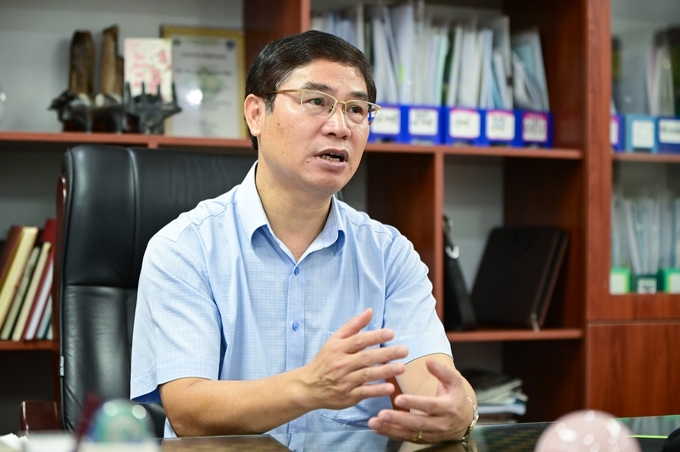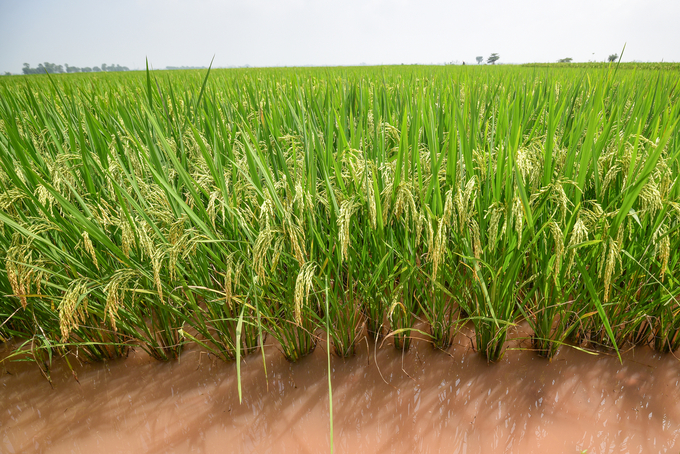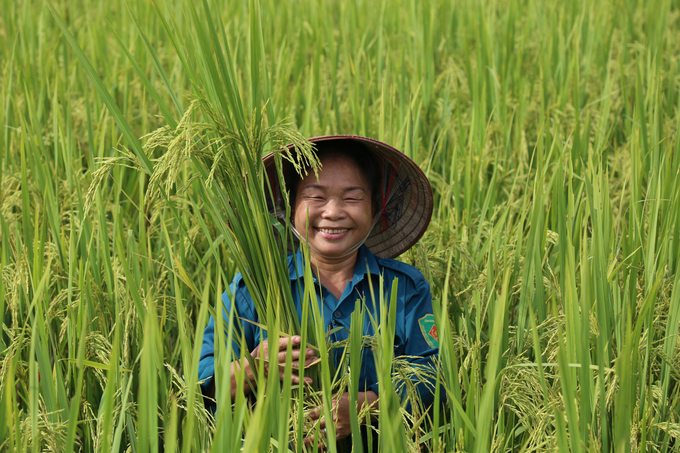May 27, 2025 | 03:07 GMT +7
May 27, 2025 | 03:07 GMT +7
Hotline: 0913.378.918
May 27, 2025 | 03:07 GMT +7
Hotline: 0913.378.918

Mr. Nguyen Quy Duong, Deputy Director of the Department of Plant Protection, discussing methods to reduce emissions in farming. Photo: Bao Thang.
Both domestically and internationally, green growth has been an increasingly popular notion in recent years. The Government has issued the Strategy on green growth development from 2021 to 2030, with a vision towards 2050.
There are two key prerequisites for green growth in agricultural and particularly rice production. Firstly, the consumption of input materials must be reduced.
Key rice production areas in Vietnam such as the Mekong Delta must first reduce the amount of seed used. The reduction of rice varieties will also lower the amount of water used in farming as this is an important and exhaustible resource.
Furthermore, farmers must reduce the amount of fertilizers used, with a special focus on decreasing the amount of inorganic fertilizers and increasing the amount of organic fertilizers. Additionally, farmers need to reduce reliance on chemical pesticides and increase the use of biological pesticides.
Secondly, green growth requires emissions reduction. Rrice production currently has the highest level of emissions among the agricultural fields. As a result, it is necessary to bring scientific and technological elements into production to reduce greenhouse gas emissions.

The current System of Rice Intensification is operated effectively and extensively in Hanoi. Photo: Tung Dinh.
Regarding the two aforementioned requirements, key rice production areas such as the Mekong Delta continue to be constrained by a bottleneck caused by inefficient agricultural practices and an excessive usage of seeds.
Rice farmers in Northern Vietnam use between 30 and 35 kilograms of seed per hectare. However, this figure rises to a staggering 120 to 150 kilograms in the Mekong Delta. The agricultural sector has implemented the VnSAT Project within the last five years in order to bring the total amount of seeds used in the Mekong Delta down to 80 to 100 kilograms per hectare. The Project has only been deployed on 200,000 hectares, whereas the total rice production area in the Mekong Delta is approximately 1.6 million hectares.
In addition to seeds, the use of fertilizers, pesticides and water is at an alarming level. This is a bottleneck that exists in Vietnam's key rice production areas, especially in the southern region.
Contrary to the popular belief that emissions reduction can reduce productivity, these two factors are integral to the production of rice.
The Ministry of Agriculture and Rural Development is currently guiding farmers to apply modern and efficient farming techniques such as "1 must, 5 reductions", "3 reductions, 3 increases", IPHM (formerly IPM), SRI, etc. Accordingly, productivity and emissions reduction are directly correlated.

The System of Rice Intensification in Hanoi has demonstrated that emission reduction, productivity, quality, and production efficiency are directly correlated. Photo: Tung Dinh.
The effectiveness of these solutions as well as the VnSAT Project has proven that emission-reducing farming not only reduces the amount of seeds, fertilizers, pesticides and water but also helps increase productivity compared to traditional farming methods.
The application of scientific and technical advances in agricultural production helps increase productivity and quality of rice. Subsequently, they improve selling prices and raise economic efficiency for farmers.
As a result, emission-reducing production and green growth will promote and supplement the improvement of rice productivity and quality.
Nevertheless, there are certain obstacles to the implementation of these methods, one of which being the lack of awareness. Namely, many local governments are unaware of the importance of rice and farming efficiency in lowering emissions and input costs.
Provinces that are well-informed regarding these issues will implement appropriate measures throughout its entire governance system. If the local Sub-Departments of Crop Production and Plant Protection or the Provincial Departments of Agriculture and Rural Development are the sole facilitators, the scale will be limited and difficult to replicate.
A detailed example of the involvement of provincial/city leadership and their evident effectiveness is the implementation of SRI in Hanoi. In addition to the exceptional resources, Hanoi's leadership is astutely aware of emission reduction in rice production. As a result, the city has effectively implemented related programs. SRI farming in Hanoi has seen significant development over the years. Most notably, a number of farms in Hanoi has eliminated the reliance on pesticides, with only one to two uses per crop.

Emission-reducing rice farming is cost-effective, resulting in higher yields, quality and profits. Photo: Tung Dinh.
With a clear perception, the government can raise the awareness of its officials and people. Consequently, Vietnam needs to mobilize and propagate with a focus on raising awareness to remove this bottleneck.
The second problem facing green growth is production organization. Businesses participating in the rice production chain have the potential of leadership if production is linked and organized effectively.
By introducing quality requirements for the output, businesses will create changes in production organization. Moreover, they can apply scientific and technological advancements to production areas in order to achieve synchronization and unity.
Well-connected regions will have stable product output and quality, preventing heavy economic losses.
In order to further improve the efficiency of emission-reducing farming with an emphasis on green growth, the Department of Plant Protection is focusing on implementing programs that inherit the integrated pest management program (IIPM) since 1992. A notable example includes the integrated plant health management (IPHM) program sponsored by the United Nations' Food and Agriculture Organization.
The IPHM program has been launched since 2021 with the support from FAO. Its extensive application in agricultural production will help improve rice productivity and quality, the environment, "soil health" and reduce greenhouse gas emissions.
The Department of Plant Protection has established a team of ToT trainers to develop the IPHM program across 63 provinces in Vietnam over the last three years. Approximately 100 national trainers and nearly 300 provincial trainers have enrolled in this program.

SRI farming in Hanoi not only helps promote the growth of rice, but also improves the environment and the reproduction of organisms living in the rice fields. Photo: Tung Dinh.
IPHM has been included in the sustainable development strategy of Vietnam's agricultural sector. According to the Ministry of Agriculture and Rural Development, IPHM will continue to be included in the scheme of the crop production development strategy until 2030, with a vision towards 2050.
Plant health management is the optimal development direction for the crop production sector as well as the plant protection sector.
The Ministry of Agriculture and Rural Development has invested extensively in the IPHM program. Additionally, the Ministry has funded annual training courses for ToT trainers and FFS (Farmer Field School) classes.
The Department of Plant Protection is looking forward to the continued support from the Ministry of Agriculture and Rural Development. In addition to funding, the Department of Plant Protection will have the opportunity to coordinate with related units including the Department of Crop Production or the National Center for Agricultural Extension. Subsequently, stakeholders can establish a team of lecturers and expand the IPHM program to other key crops.
The Department of Plant Protection aims to include green growth and emission reduction strategies in the resolutions at the provincial and municipal Party Committee levels, creating a foundation for action plans that will be implemented by relevant agencies.
In order to achieve green growth and reduce emissions, Vietnam must deploy integrated actions, with resources from central and local levels, accompanied by financial support and experience from international organizations.
Translated by Nguyen Hai Long
/2025/05/25/4127-3-073637_820.jpg)
(VAN) Thanks to the promotion from an FAO-implemented project, vegetable production in greenhouses in Moc Chau has seen strong development, from 1.5 hectares in 2021 to nearly 50 hectares in 2024.

(VAN) FAO has recently supported USD 140,000 to implement the project 'Risk mitigation human-animal interface risks through disease control initiatives in pig farming.'

(VAN) The People's Committee of Tra Vinh province has approved an adjustment to the investment policy for the Green Hydrogen Plant project, increasing its area to approximately 52.76 hectares.
![Reducing emissions from rice fields: [2] Farmers’ commitment to the soil](https://t.ex-cdn.com/nongnghiepmoitruong.vn/608w/files/news/2025/05/05/dsc08881jpg-nongnghiep-140632.jpg)
(VAN) Clean rice cultivation model in Thuong Tan commune, Bac Tan Uyen district, is assisting local residents in achieving sustainable agriculture by substantially reducing costs, increasing productivity, and protecting the environment.

(VAN) At the conference to disseminate Resolution No. 68, AgriS introduced its digital agricultural ecosystem and reaffirmed its commitment to accompanying the Government in promoting private sector development and sustainable agriculture.

(VAN) 'Blue Ocean - Blue Foods' initiative is designed to restore marine ecosystems and establish sustainable livelihoods for local communities by cultivating a minimum of 1,000 hectares of cottonii seaweed in the first three years.
/2025/05/21/4642-3-112707_603.jpg)
(VAN) The V-SCOPE project has made direct contributions to three out of six pillars of the Comprehensive Strategic Partnership between Vietnam and Australia.